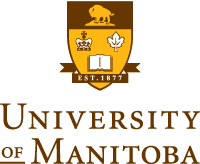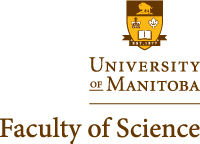2014 CMS Summer Meeting
University of Manitoba, June 6 - 9, 2014
Mathematics: Tools of investigation in cellular and molecular biology
Org: Eric Cytrynbaum (UBC) and Stephanie Portet (Manitoba)
[PDF]
Org: Eric Cytrynbaum (UBC) and Stephanie Portet (Manitoba)
[PDF]
- AIDAN BROWN, Dalhousie University
Ubiquitin and adaptor protein dynamics on mammalian peroxisome membranes [PDF]
-
Peroxisomes are membrane-bound organelles within eukaryotic cells that post-translationally import folded proteins into their matrix. Matrix protein import involves a shuttle receptor protein, usually PEX5, which is ubiquitinated during the import process. The translocation of the cargo protein into the matrix is not well understood, and its energetics remain controversial. We stochastically model different ways AAA ATPase-driven removal of PEX5 could couple with cargo translocation. We find that translocation coupling involving more than one PEX5 produces a qualitatively distinct ubiquitin signal. Recent work has shown that ubiquitin on mammalian peroxisome membranes can lead to selective degradation by autophagy, i.e. ‘pexophagy.’ Our results indicate that low cargo traffic could lead to a natural disuse signal enhancing pexophagy. Adaptor proteins couple ubiquitin to the autophagy machinery. One such adaptor protein for peroxisomes is NBR1, which both sticks to membranes and self-interacts. To understand factors other than ubiquitin leading to selective pexophagy, we model NBR1 dynamics on peroxisomes. We consider individual NBR1 clusters on peroxisomes growing and shrinking and find their coarsening behaviour depends upon the radius distribution of peroxisomes in the system. The radius distribution can change both the power law for cluster growth as well as cluster size distributions. We find that clusters evaporate from small peroxisomes first, concentrating adaptor proteins on larger peroxisomes, independent of the sphere size distribution. This suggests a cellular mechanism for using self-interacting adaptor proteins to bias degradation towards larger organelles.
- ERIC CYTRYNBAUM, University of British Columbia
Estimating the bending modulus of a FtsZ bacterial-division protein filament [PDF]
-
FtsZ, a cytoskeletal protein homologous to tubulin, is the principle constituent of the division ring in bacterial cells. It is known to have force-generating capacity in vitro and has been conjectured to be the source of the constriction force in vivo. In this talk, I will describe our recent efforts to use modeling and data fitting to identify possible mechanisms by which the division ring generates force.
- ADRIANA DAWES, Ohio State University
EGF and Notch signalling in Caenorhabditis vulval development [PDF]
-
During development, many cells respond to signals in their environment by taking on a specific fate. Nematode worms of the Caenorhabditis genus develop an egg laying structure called the vulva, and this structure is highly conserved across species. I will discuss a mathematical model of Caenorhabditis vulval development that incorporates signalling by the EGF/Ras pathway and the Notch pathway, two common and conserved modules in eukaryotic organisms. By studying differences in cell fate specification between Caenorhabditis species, we will demonstrate how cellular responses are regulated by the underlying signalling network. This work is joint with Helen Chamberlin (Molecular Genetics, Ohio State University).
- ALEXANDRA JIKINE, University of Notre Dame
An interlocked feed-forward loop circuit can explain the phenotypic heterogeneity of fat-cell differentiation. [PDF]
-
Adipogenesis, the differentiation process of adipocyte (fat cell) formation from precursor cells contributes to increase of fat tissue in obesity. Population-averaged analysis predicts that during adipogenesis many adipocyte-specific proteins increase monotonically in time. However, previous work has found that some of these proteins, namely the hormone adiponectin, and transcriptional regulators PPAR gamma, andC/EBP alpha, increase and then decrease significantly during differentiation. The observed monotonicity is simply an illusion of population averages. Instead, there is a group of cells with high adiponectin and low lipid droplet level, and another group of cells with high LD, but low adiponectin. It was suggested that these subpopulations correspond to different temporal stages of adipogenesis. Three coupled network motifs found in adipocytes can explain these observations. PPAR gamma and C/EBP alpha trigger an incoherent feedforward loop in adiponectin production, leading to a pulse of adiponectin that disappears after a few days. A coherent feedforward loop in lipid synthesis leads to a delayed production of lipid droplets. Other systems that have an interlocked FFL circuit, also exhibit this pattern of a pulse of ’early’ gene expression followed by expression of the ’late’ genes.
- FRANCIS LIN, Univ. of Manitoba
Studying Directed Cell Migration Using Microfluidic Devices and Quantitative Modelling [PDF]
-
Directed cell migration is a complex and highly coordinated biological process with important relevance to various physiological functions and pathological problems. Understanding directed cell migration requires the researcher to approach it as a complex interacting network of guiding cues, the responding cellular machinery and the extracellular matrix. Microfluidic devices provide a powerful experimental platform for cell migration analysis in controlled cellular guiding microenvironments. Such experimental studies further facilitate the development of quantitative models for directed cell migration. Toward this direction, we study cell migration in complex chemical and electric fields using a combination of microfluidic experiments and quantitative modelling. In this talk, I will discuss a few focused studies including 1) chemotactic navigation in complex assays of chemoattractant gradients; 2) lymphocyte migration in lymph node relevant co-existing chemokine fields; 3) cell migration in competing chemical gradient and electric field.
- STEPHANIE PORTET, Department of Mathematics, University of Manitoba
Modelling intermediate filaments [PDF]
-
Intermediate filaments are one of the components of cytoskeletal networks that are involved in major functions in the cell. Understanding the assembly of intermediate filaments, their organization in networks and resulting mechanical properties is essential to elucidate their functions in cells. I will present computational and mathematical models of the complex processes of intermediate filament assembly and network organization.
- BLERTA SHTYLLA, Pomona College
Mathematical models of force generation at the cellular nanoscale: interplay of protein flexibility and diffusion. [PDF]
-
At the cellular micron-scale, force generation and transport requires the rectification of diffusive motion. Such a task is no small feat particularly as several mechanical events in our cells need to be highly precise in their action. In response to these needs, cells have evolved exotic nano-machines that can harness diffusion to complete their tasks. In this talk, I will discuss mathematical models of the mechanisms driving cell division nano-machines, called kinetochores. These highly specialized structures assemble on chromosomes during mitosis and mediate the equal partitioning of our genetic material. Using modeling, we will show that diffusion and specialized binding architectures can be used to generate directed kinetochore movement. Internal protein compliance can have a surprising role, which we show can be rather similar to the muscle contraction paradigm.







